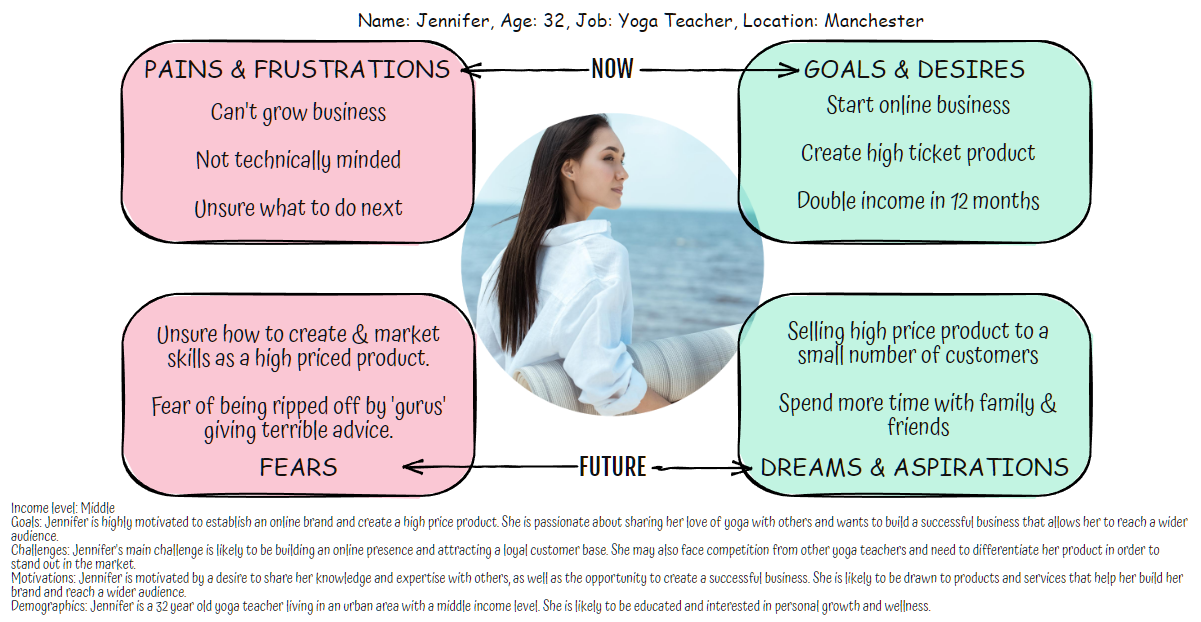
Understanding who your target audience is key when it comes to developing successful marketing campaigns.
Building a customer persona is the best way to understand your ideal customer and develop strategies to reach them.
In this blog post, we’ll be going over the steps to create an effective buyer persona for your business. Let’s get started!
What is a customer persona?
A customer persona is a representation of your ideal target customer. It takes into account factors such as demographics, behaviour patterns, motivations, and goals. By understanding your persona, you can more effectively market to them and create content that resonates.
Creating a persona is an essential part of any branding strategy because it gives you a better chance of getting the right message to the right people.
The goal is to make your brand more relatable and authoritative in the eyes of potential customers.
The process of creating a persona begins with research into who makes up your target audience. This includes things like age, gender, location, job title, income level etcetera. Once you have this basic information about who you want to reach, you can start digging deeper into their individual needs and wants.
Gaining insights into their motivations, goals, and challenges, allows you to create content, products, and services that address their needs specifically. Through developing customer personas, you can make sure that your marketing campaigns are tailored to the right audience to maximize results.
By studying the data from surveys, interviews, and other sources of information, you can create comprehensive personas that represent the key characteristics and behaviours of your ideal customers.
This information should give you insight into how best to serve them, how best to market your product or service, and what types of messages they will respond to.
Creating a persona is the second stage of our Growth Jetpack framework that’s designed to help you build high ticket products fast. Want to know what the other steps are?
7 Steps To Creating a Customer Persona
Now you understand that this is a useful exercise that can help you understand your target audience and create marketing campaigns that are more targeted and effective, let’s move on to the seven steps you can follow to create a customer persona:
- Define your target audience: Start by identifying the characteristics of your ideal customer, including their age, gender, location, and income level.
- Gather data: Collect data on your target audience through online research, customer surveys, and interviews with current customers.
- Analyze the data: Look for patterns and trends in the data you have collected, and use these insights to create a detailed profile of your customer persona.
- Give your persona a name: Naming your customer persona can help you personalize your marketing efforts and make your messaging more relatable.
- Define your persona’s goals and challenges: Consider what motivates your customer persona, and what challenges they may face when trying to achieve their goals.
- Determine how your product or service fits into their life: Think about how your product or service can help your customer persona achieve their goals and overcome their challenges.
- Create a detailed profile: Use all of the information you have gathered to create a detailed profile of your customer persona, including their demographics, goals, challenges, and motivations
By following these steps, you can create a customer persona that will help you understand your target audience and create marketing campaigns that are more effective and relevant.
At the end of the process you should not only have the key stats, but a full backstory, for example:
Name: Jennifer
Age: 32
Occupation: Yoga teacher
Location: Urban area
Income level: Middle

Goals: Jennifer is highly motivated to establish an online brand and create a high-priced product. She is passionate about sharing her love of yoga with others and wants to build a successful business that allows her to reach a wider audience.
Challenges: Jennifer’s main challenge is likely to be building an online presence and attracting a loyal customer base. She may also face competition from other yoga teachers and need to differentiate her product in order to stand out in the market.
Motivations: Jennifer is motivated by a desire to share her knowledge and expertise with others, as well as the opportunity to create a successful business. She is likely to be drawn to products and services that help her build her brand and reach a wider audience.
Demographics: Jennifer is a 32-year-old yoga teacher living in an urban area with a middle income level. She is likely to be educated and interested in personal growth and wellness.
By creating this customer persona, you can better understand Jennifer’s needs and motivations, and create marketing campaigns that are tailored to her interests and goals.
A key component of any good story is the protagonist’s backstory. Developing a complete customer persona for your brand will make them feel real and relatable.
When crafting your customer’s backstory, consider where they came from, what events have led them to be interested in your product or service, and how their life has been up until now.
It’s helpful to find a relevant image to use to represent them and make them more real.
Key Elements of a Successful Buyer Persona
A successful buyer persona should be detailed and comprehensive, taking into account factors such as age, gender, location, and interests. When creating a customer persona, it’s important to think about who the customer is, what their purchasing behaviour is like, and what motivates them to make decisions.
Gathering data from customer surveys, interviews and other sources can help shape the customer persona in order to effectively reach potential buyers.
Building brand authority and credibility: By establishing a strong brand, you can attract buyers who are looking for quality products and services. You can also build trust and loyalty with your buyer persona by providing exceptional value.
Increasing online leads and sales: By creating an engaging lead magnet or bait, you can increase the number of leads that turn into sales. Additionally, by upselling your buyer persona on additional benefits of your product or service, you can increase your ROI significantly.
Improving your ROI: By identifying the key elements of success for a buyer persona, you can focus on delivering value to your target audience in a way that is both relevant and valuable. This will result in increased online traffic and conversion rates overall.
Personas should be regularly updated to reflect changes in customer behaviour and preferences. By having an up-to-date understanding of customers preferences, companies can more effectively craft strategies to increase sales and meet the demands of their target audience.
Once you know who your target customer is, you should understand what their goals and motivations are. This will help you better align your marketing message with their needs, helpoing you create content that speaks directly to your ideal client.
Ask yourself questions such as “What does this person want achieve?” and “Why do they want it?”.
If you’ve developed a successful persona, you should be able to talk about them as if they’re a real person.
Tools to help create personas
Creating an in-depth persona is a lot of work. Fortunately, there are now tools available to help with this task, and the one I use with clients is CrawlQ.
CrawlQ is an AI-Powered audience research and content writing tool that generates detailed customer persona and copy to appeal to that specific customer.
In the video you can see it doesn’t take very long to research and create a new persona, and I very quickly gained additional insights:
Identify 3 current dilemmas of my Ideal Prospect
1. He doesn’t have enough time to go to the gym or yoga classes.
2. He is looking for a way to improve his health but doesn’t have the money to go to the gym or yoga classes.
3. He is suffering from back pain and neck pain.
Identify 3 current daily routines of my Ideal Prospect
1. Checking email and social media first thing in the morning
2. Taking a break for lunch between 12pm-1pm
3. Working on projects from home after work (between 7pm-10pm)
Identify top 5 inspirations my Ideal Prospect is seeking
1. Relief from back and neck pain
2. Improved health without having to go to the gym or a yoga class
3. Quick results, ideally in less than an hour
4. Affordable price
5. Support and guidance from a successful entrepreneur
Identify 5 triggers
1. The price is $2,500.
2. I am a yoga and meditation teacher who has been teaching for over 10 years.
3. You can get a demo call with me to get a price now.
4. I have created many different products that have helped thousands of people to improve their health, happiness and well-being.
5. My courses have helped people from all around the world achieve their goals and live happier lives.
Identify 5 barriers
1. The price is too high for many people.
2. It’s difficult to know if the course is worth the investment without trying it first.
3. The course is only available in a few locations.
4. There is a lot of competition in the yoga industry.
5. It can be challenging to find time to commit to a new course or program
Identify 5 likely convert touch points to buying decisions
Price, quality of instruction, location, convenience, community
Identify 5 likely purchase intent touch points to buying decisions
1. Needs assessment – Does the customer feel they have a problem that needs solving?
2. Research – Does the customer do their own research or seek out recommendations before making a purchase?
3. Comparison shopping – Do customers compare prices and features before making a purchase?
4. Brand loyalty/trust – Does the customer trust and prefer certain brands over others?
5. Gut feeling/emotional connection – Does the customer make decisions based on their gut feelings or emotions?
Identify 5 essential product features priorities to make a buying decisions
1. Relief from pain – The product should be able to relieve pain in the back and neck.
2. Quick results – The product should show results within minutes or hours, not days or weeks.
3. Low cost – The product should be affordable for people like Srinivas who have no time or money to go to the gym or yoga classes.
4. Convenience – The product should be easy to use and can be used at home without having to go anywhere.
5. Quality – The product should be of good quality and meet the standards of a good yoga class or gym workout session
Identify 5 inner driven attitudes of my Ideal Prospect
1. They are looking for a way to improve their health and want to find the best possible option.
2. They are time-poor and need something that can give them results in less than an hour.
3. They are willing to invest money in order to improve their health.
4. They are motivated by the desire to help others achieve success.
5. They are looking for a reliable, trustworthy source of information on yoga and health
Identify 5 outer driven attitudes of my Ideal Prospect
1. They are looking for a way to improve their health without spending a lot of time or money.
2. They are looking for a solution that will give them quick results.
3. They are motivated by the desire to be healthy and successful.
4. They are willing to invest in their health and well-being.
5. They are interested in learning about new ways to improve their health and wellbeing.
Identify 5 Fluidity & Openness to change factors of my Ideal Prospect
1. Age: 37 years old
2. Profession: Tech professional working in a big financial services company
3. Back pain and neck pain: Suffering from these pains
4. Desire to improve health: Wants to be healthy but has no time and money to go to the gym or yoga classes
5. Urgency: Sees the need to improve health quickly, within less than an hour
Identify 5 Consistency & Routine factors of my Ideal Prospect
1. They are committed to improving their health and wellbeing.
2. They have back pain or neck pain.
3. They do not have time to go to the gym or attend yoga classes.
4. They are looking for a way to improve their health in a short amount of time.
5. They are willing to invest in their health and wellbeing.
How Can Creating a Persona Improve Your ROI?
By using a winning persona construction approach, you can tailor your marketing strategies to target specific customer segments. This customization can lead to higher conversion rates and increased customer engagement, ultimately improving your ROI. Understanding your audience on a personal level allows you to create content that resonates with them on a deeper level.
Final Thoughts
In conclusion, creating a customer persona is an important step in understanding and effectively marketing to your target audience.
By following the seven steps outlined in this article, you can gather valuable data on your ideal customer, analyze that data to create a detailed profile, and use that information to create marketing campaigns that are more targeted and effective.
Whether you are a small business owner or a large company marketer, a well-defined customer persona can help you create messaging that resonates with your customers and better understand them.
By taking the time and effort to create a customer personality, you can better serve the needs of your customers and increase your business’ success.
- How to Plan a Content Calendar That Works - 29/10/2025
- SEO Content vs. Social Media Content: What’s the Difference? - 23/10/2025
- The Best Types of Content for Service Businesses - 16/10/2025


